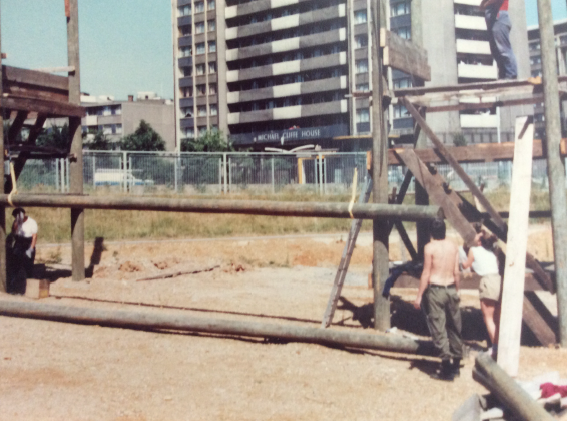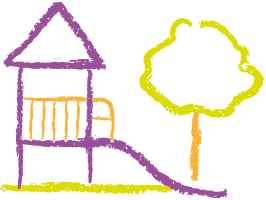Being a volunteer for Islington Play Association
It was 1973 and I’d just finished school, for good. I was due to go to university in the autumn, and really wanted to do something ‘different’ before I went. Friends were going off on ‘gap year’ activities, off to exotic places some of them. I saw an advertisement in Time Out – which was then part of the radical underground press – for volunteers for the summer only, for the Islington Play Association. I applied without giving it any thought – it just seemed a good opportunity, something new. I didn’t know anything about working on a playscheme, I didn’t even know what an ‘adventure playground’ was, but this didn’t bother me.
The Association was looking for volunteers because there were summer play schemes to run and council workers had gone on strike. I was living in a commuter town in Hertfordshire at the time, but I’d lived in north London for the first ten years of my life so it wasn’t strange to think of being in Islington for a couple of months.
Carrying mattresses to our home for the summer
The first thing I remember was arriving at Kings Cross station and heading for Copenhagen Street for some kind of training meeting. The training was brief, and I’m afraid, unmemorable. There were maybe 10-15 of us, most or maybe all of the volunteers older than me. Afterwards we were led off in a kind of crocodile line, two by two, carrying old mattresses along the streets to our home for the summer – a condemned house in Stanmore Street, just off the Pentonville Road.
When we arrived we saw neighbours standing in the street, understandably suspicious of this group of untidy young people who (we were told) they had been assured were ‘useful’ local volunteers. The street was due for demolition so eventually everyone would be moved out. We felt rather guilty about moving into a house where a family had recently been evicted.
The house had an outdoor toilet, electricity, but no bathroom, and when we arrived it had no furniture that I can recall. There was only one double bed, otherwise, we were to sleep on the limp-looking old mattresses on the floor. We drew lots for the double bed, and a girl I’d only met a few hours before and I got lucky and got to share it. Later in the week, I think we were given a table and chairs, and there were plates and cups in the kitchen, and a few pans. Somebody brought a record player and some Joni Mitchell records. That was about it. I’d never lived away from home before and was the youngest person there. It was all very exciting and my memory is that I didn’t worry too much about how I would manage.
We weren’t paid of course, but we were given a small weekly amount for food, and it was agreed we would take it in turns to cook. I’d never cooked for a lot of people before. Within a few days of moving in I was in a public phone box ringing my mother. ‘Kedgeree’, she recommended, and gave me instructions.
The playgrounds were a jumble of broken wood
We were each allocated a different playground and arriving on the first day was frankly terrifying. I didn’t know what I was going to be able to do, and felt all the pressure of needing to be accepted by the children, the leaders, and the parents. Then the first time I saw a playground I found the look of it really alarming. Tall, dark, looming structures with swinging ropes and masses of black tyres towered behind high wire fences, surrounded by derelict buildings.
The playgrounds were often just a jumble of broken wood, with occasional railway sleepers providing a bit of stability underneath. Everything on the playground looked as if it had just been thrown together. Having grown up seeing photographs of bombed-out sites in London, that’s what I thought of when I saw my first one. An impression of dark, slightly threatening-looking scaffolding, crammed together in the corner of a street, with no colour or greenery to lighten the look. A few of the playgrounds had completed structures where you could see a route for children to swing and climb, but many playgrounds were still in the process of construction and were literally building sites. I’d never seen anything like it. I soon learnt that children loved the freedom of the spaces and didn’t find them threatening at all. Over the first few days, watching how the children played, I got over the feeling these were gloomy places and saw them as wild and free instead.
We were moved around quite a bit on a daily basis, sent to different playgrounds depending on their particular plans or projects for the day. I don’t know how ‘health and safety’ issues were managed then – the building of the playgrounds seemed a casual procedure with few checks and controls. We were given a very basic introduction to how the play structures were to be built, and what was expected of us as volunteers, but I doubted that I was going to be able to do any of this. Just as there seemed few checks on the construction, there had been no real checks on us as volunteers. I don’t remember having to provide any kind of reference, for instance.
Fortunately, there were skilled play leaders at each playground so we only had to do as we were told, though I often felt out of my depth. I never got involved with construction work, but I did help with arranging activities, that were usually decided by the main playground leader. The leaders were paid I think – I don’t know where they came from. They all seemed very competent young men, popular on the playground and very pleasant to us. The main person I worked with had recently arrived from Iran, but I don’t know how he ended up working on a playground – he was only in his early 20s.
The playgrounds were more like community clubs. Children of all ages attended, from 4-year-olds to 17-year-olds, and there were different age groups hanging around together, plus the occasional group of parents chatting on a bench nearby. It’s notable, now I think about it, that the volunteers were, I think, all female, whereas the playgrounds had a higher proportion of boys than girls. Occasionally there were mild fights between them, but I don’t remember being threatened myself either on the playground or in any of the nearby streets. It was remarkable just how well everyone seemed to get on and that there were no accidents, in what could have looked like a rather wild environment.
Not all the children who used the playground were especially keen on the physical challenges the playgrounds provided, and many were too young to use the structures, so we organised other activities – games, competitions, themed events – but I can’t remember much more about them. A lot of the ‘children’ were taller and bigger than me, and many of them were only a few years younger, so it was hard to assert myself, as I was sometimes required to do. At one point I was sent to work at the Islington Boat Club because they discovered I knew something (though very little) about boats. I took kids out in small sailing dinghies and we drifted around the canal while I tried to work out how to get us back to the canal side. I don’t think I was much more use there than I was on the playgrounds, but I hope as an extra helping hand I contributed something.
The challenges of daily living
Meanwhile living in Stanmore Street became increasingly difficult. At some point the ground floor flooded, and the route to the outdoor toilet involved climbing on a series of chairs through the kitchen and out the back door and then into the toilet. Not surprisingly within a couple of weeks most of us went down with a bacterial infection. I went home for a few days to recover. My parents forbid me to return, but I did anyway. Most of the volunteers in the house had had to stay put while they were ill, recovering on their mattresses on the floor.
Afterwards, some kind of house routine emerged. The other volunteers all seemed very capable so I looked up to them and willingly took any advice. I don’t remember there being any tension which was just as well given how closely we were living. Avril, my roommate, was the only black volunteer and coming from Birmingham rather than London she felt a bit of an outsider. In fact, we were all outsiders in that none of us came from the local estates. This wasn’t something that seemed to bother anyone using the playgrounds, though looking back on it now it seems a bit strange they didn’t try to recruit local people instead.
As a teenager, I had sometimes come on the train to Islington to see live bands. At some point, while living in Stanmore street a band I knew was playing at the newly opened ‘Dingwall’s’ in Camden and I decided that I would use my remaining money to buy a ticket for it. I went on my own and had a great evening, but emerging from the venue just after midnight I was surprised to discover there were no buses or tubes to get me home. I don’t know how I managed to persuade a black cab to take me, or whether I had enough money to pay for it, but I remember when I told the driver where I wanted to be taken, at first he refused to take me there and wanted to take me somewhere else, thinking I must be in trouble if I was living in Stanmore Street. I persuaded him to drop me at the end of the street.
There were some influential groups of older children on the playgrounds and as they wielded power over the behaviour of many of the teenagers there we thought it would be useful to have them on our side. One of the ‘children’ had a car, and one evening he offered to take a few of us on an outing to Heathrow airport, just for fun. These teenagers definitely had the upper hand – the drive felt pretty wild and I remember just looking forward to getting back home in one piece.
Sometimes we invited some of the older teenagers to eat with us. We had a weekly food kitty from money given to us by the IPA, and to make it go as far as possible, at the end of every day, some of us went to the fruit and vegetable market on Islington High Street and picked up dropped or discarded items. I was a bit shocked to find myself picking food up off the street, but soon discovered you could get perfectly good vegetables that way.
Entertaining the older kids at Stanmore Street all went very well until one day we discovered that our food kitty, unwisely left out in the kitchen, was suddenly empty. It was the beginning of the week and most of us had no spare cash. There was no question of us telling anyone this had happened – we recognised it had been stupid of us not to be more careful, and reporting our suspicions would have made our lives on the playgrounds impossible. So we settled down to a week of bread and jam.
It was during that week I found myself at Kings Cross looking longingly into a small cafe, not really hungry but missing the variety of food. A man sitting inside saw me looking and stuck his head out the door and invited me in. He was American. ‘Just talk to me in your wonderful English accent,’ he said, ‘and I’ll pay for your meal’. It seemed a good deal so I said yes immediately. When he offered to walk me home (about 15 minutes walk from there) I didn’t think anything of it, unaware of the potential dangers. Fortunately, he walked me home and waved my goodbye at the doorstep, although I remember he was a bit shocked by the look of the house.
Community art projects, and looking for the sea in Southend
At that time Ed Berman was touring his Fun Art Bus around London, and Inter-Action was a fashionable group of artists that floated in and around the playgrounds. The volunteers were all invited to an Inter-Action party one night, because somehow they saw us as part of the same community ‘movement’ – but we felt rather differently about them, believing they thought themselves rather ‘above’ us, being arty types. But it was exciting to mix with different people and hear their ideas and plans for projects.
As a part of the playscheme, the Association organised some day trips for the children. I don’t know who decided on what these would be, but I was told that I would be accompanying a coach load of children to the seaside for the day. There were two or three of us volunteers on the coach, and a lot of very unenthusiastic children. I was much more excited about the prospect of seeing the sea than they appeared to be. I did my best to encourage a feeling of anticipation and excitement among them, which as it turned out was a mistake – we were on our way to Southend, and little did I know that the chance of actually seeing the sea there was minimal. Indeed there was almost a riot when the coach drew up and all the children could see was miles of mud. ‘The pier!’ we cried, ‘you can find it at the end of the pier!’. This worked fairly well I think because they liked running on the (very long) pier. But at the end of the day, there were three children missing on the coach. I vaguely remember being volunteered to go and find them and finding the exercise very stressful, wondering what would happen if I didn’t find them. Fortunately, I did.
But was I of any use?
I don’t know if over the weeks I became any more use to the playground leaders – I doubt it. I was an extra pair of hands so maybe sometimes I added something, but the benefit was mainly to me, in the experiences it gave me and lessons it taught me, mainly about my own limitations.
When the summer holidays came to an end we all went our separate ways and that was the last time I had contact with the playground movement. I stayed in touch with Avril for a few years, but no one else. That autumn I had the excitement of going to university ahead of me, but now I think that the summer spent in Islington possibly taught me more than my later time as a student. Within a few years, I was back in Islington, working for another community association.
Lynne Woodward






